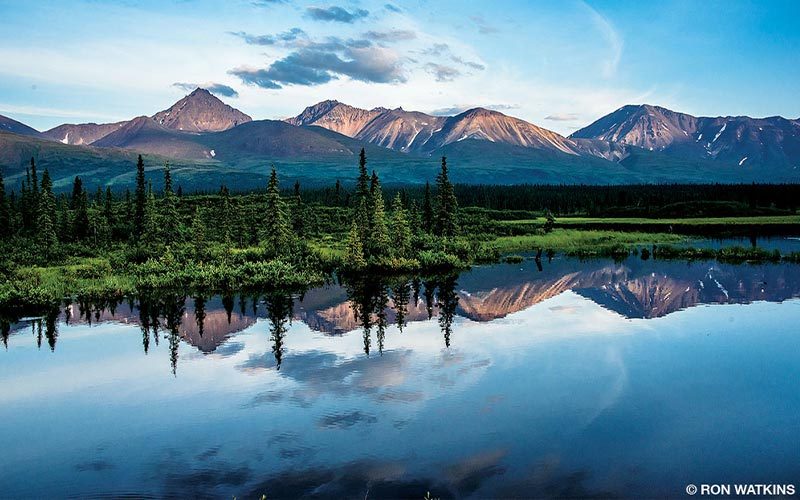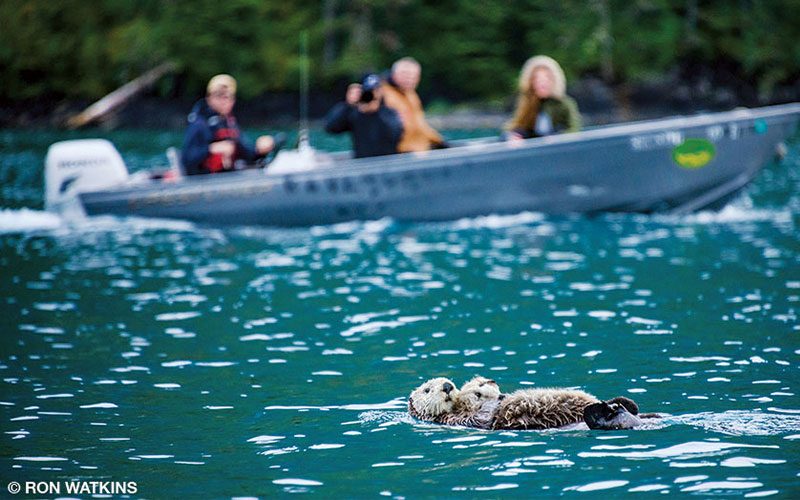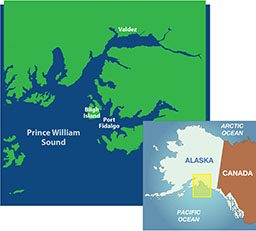Milky greenish-blue 50°F-60°F water is not what most people think about when getting excited for a dive trip, but these are the typical summer conditions in Port Fidalgo, Alaska. Located in Prince William Sound, Port Fidalgo is only a short distance from where the Exxon Valdez struck Bligh Reef in 1989, spilling 11 million gallons of Alaskan crude. But thanks to the massive cleanup effort and more than a quarter century of time to heal, almost no visible traces of this environmental disaster remain. Although the oil business and fishing are the leading industries in the region, nature tourism and diving are becoming increasingly popular and may be the keys to preserving this natural wilderness.
One of the main attractions for divers is the annual migration of salmon sharks that feast on the spawning pink and chum salmon that return to the area’s streams to complete the circle of life. This is the best place in the world to get a glimpse of these sharks, and researchers and documentary crews from The Discovery Channel, BBC, Animal Planet and Nat Geo Wild have visited here. But these waters, coastlines, glaciers and surrounding wilderness areas are home to much more — the abundance of wildlife above and below the surface makes this place truly special.

The last leg of our journey to Port Fidalgo was a two- to three-hour boat ride from Valdez Harbor. It’s not uncommon during this scenic ride to see whales, seals, sea lions, sea otters, dolphins, bald eagles and waterfowl such as puffins. The entrance to Port Fidalgo, surrounded by towering green mountains and shrouded by a soft layer of clouds, is a breathtaking sight.
Weather permitting, we spent most mornings searching for salmon sharks. Finding these elusive sharks requires little or no wind and calm water so the dorsal fins are visible on the surface. Salmon sharks are extremely skittish, and before we could dive with them our guide had to identify a cooperative shark — “a player” — that was willing to follow a herring tied to the end of a fishing line (no hooks) and entice it close to the boat and the waiting snorkelers. This proved to be quite challenging, and at the end of my first trip to Fidalgo, I, like many other photographers, left with no underwater images of salmon sharks. Patience and persistence eventually paid off, and we captured some great images of the sharks during our second trip.

While searching for salmon sharks you will often come across expansive white blooms of thousands of moon jellyfish, providing a truly surreal diving experience. The jellyfish can be so dense they block out the sun. Among these delicate jellies you will also find one of their predators: the bright orange and yellow lion’s mane jellyfish. If you are truly lucky, in the bloom you will find the female moon jellyfish, which can be identified by its pink or purple color.

We spent our afternoons visiting a series of interesting dive sites: kelp beds, sloping underwater rock formations covered with towering white plumose anemones, and sand bottoms covered with patches of eel grass. A few of my favorite sites in Port Fidalgo are Luke’s Wall, Octipillars, Razor’s Edge and Manomi’s Rocks. Dive sites are chosen based on tides, currents and visibility, and each features unique topography and various coldwater fish such as sculpin, decorated warbonnets, numerous species of rockfish, halibut and the magnificently colorful Irish lord. You might even spot a wolf-eel or a giant Pacific octopus (GPO) hiding among the rock formations. There is also a diverse array of nudibranchs, shrimp, crabs, scallops and small bottom-dwelling fish that will satisfy any macro photographers in the group.
One of easiest dive sites is right off the dock at Ravencroft Lodge. The eel grass and sand bottom teem with hooded nudibranchs, lingcod, copper rockfish, decorator crabs, helmet crabs and an old mining cart that fell off the original dock more than 100 years ago.
My time in Port Fidalgo reminds me of my childhood summer camp trips, roughing it in the wilderness, getting away from it all, doing fun activities during the day to connect with nature, meeting new people and sitting around the campfire or lodge telling tales. Even in the long Alaskan summer days with more than 20 hours of daylight, there seems to never be enough time to do everything you want to do. Before you know it, summer camp is over, and you have to pack up, say goodbye and head home. But you leave with lasting memories, perhaps some amazing pictures of salmon sharks and a strong desire to return and relive those adventures in the wild.
How to Dive It

Getting there: Most major cities offer multiple daily flights to Anchorage, Alaska, in the summer. From Anchorage you can connect via local airlines to Valdez, where it is recommended that you arrive at least a day before being picked up for your transfer to Port Fidalgo. Instead of flying, you could make the six- to seven-hour scenic drive to Valdez. Take your time, and stop frequently to view the glaciers, flower-covered meadows, lakes, marshes, rivers and mountain overlooks, and watch for wildlife. When you reach Valdez, there is plenty to see and do, but book your accommodations early because they tend to fill up quickly.
Conditions: The waters of Port Fidalgo are quite cold and range from the mid- to high-50s°F at the surface to high 40s°F at depth. Brave and/or cold-tolerant people might find a 7 mm or 8 mm wetsuit with hood and gloves sufficient for snorkeling with the sharks on the surface. But a drysuit is definitely recommended for scuba diving. Visibility ranges from 10-40 feet during the summer months.
Topside: Head to the local salmon stream to photograph the chum and pink salmon swimming upstream to spawn. Bald eagles are common in the area, and you can visit one of many nearby nesting areas by boat to photograph eagles in the trees, soaring overhead or swooping down to snatch a herring out of the water. Sometimes the boat will just cruise the shoreline in search of wildlife such as river otters, elusive black bears, sea otters floating on their backs (perhaps with babies on their chests) and seals poking their heads just above the water. You can also take an excursion to nearby Columbia Glacier or the local Steller sea lion colony.
| © Alert Diver — Q4 2017 |